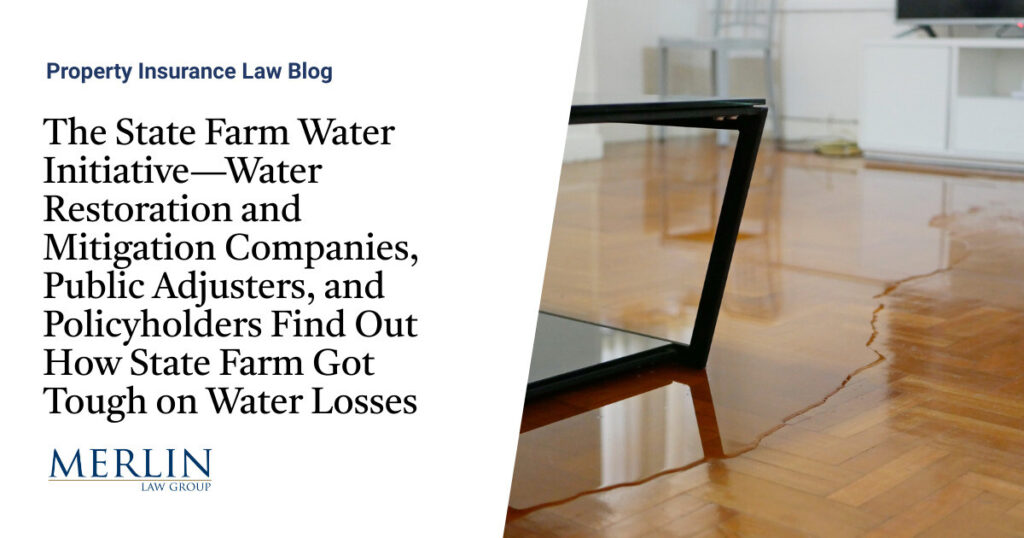The State Farm Water Initiative—Water Restoration and Mitigation Companies, Public Adjusters, and Policyholders Find Out How State Farm Got Tough on Water Losses

State Farm started a “Water Initiative” in 2017 to reduce claims adjustment expenses and reduce payments regarding water losses. While the current litigation exposing this claims process is primarily in California, the program is obviously being applied in a number of other states. Since water loss claims are the most frequent type of loss, it does not take a financial genius to figure out that by reducing payments on water losses, this change of claims handling could result in significant savings to State Farm.
From information gleaned In a Lex Machina search and a motion to compel the production in a case that recently settled, those in litigation with State Farm regarding denied or underpaid water loss claims should ask for the following to get a better understanding of how State Farm’s “Water Initiative” impacted your loss:
All documents regarding the ‘Water Initiative’ including but not limited to:
1. Water Damage Coverage Analysis (HW-2100 Series) Workday
2. Water Damage Coverage Analysis (HW-2100 Series) course in Workday
3. Water Coverage Introduction and QFC VOD
4. Water Coverage Investigation VOD
5. Introduction to Water Losses VOD
6. Water Coverage – Plumbing
7. TIPP
8. Water Loss Scenarios course in Workday
9. Fill-Up Water Loss VOD
10. Water Classes and Categories Job Aid
11. Quality First Contact Guide – Fire [Note: At State Farm, “Fire” is a reference to non-auto policies, including those like the policy at issue here, which cover some water losses]
12. Water Mitigation- Xactimate Codes and Pricing VOD
13. Water Mitigation- Drying Equipment Calculations VOD
14. FAQs on Water Mitigation Summary Report Workflow
15. Fire Property Water Mitigation Training Support Guide – JA
16. Water Mitigation Estimate Review Job Aid
17. Estimating Topics – All
18. Xactimate- Changing a Component Price Job Aid
19. Reparability of Solid Wood Floor Coverings- Video on Demand
20. Water mitigation claim Handling Refresher
21. Water mitigation Job Aid
22. Water Category and Class
23. Wood Floor Damage Job Aid
24. Flooring Course in Workday
25. Masking Job Aid
26. Drywall/Paint/Insulation/Trim/Cabinets/Countertops in Workday
27. Water Claim Handling Estimatics Considerations
28. Xactimate – All Topics
29. Fire Property Water Mitigation Training Support Guide – JA
30. Residential Interior Floor Coverings course in Workday
31. “Water Initiative” Power Point(s) or other presentation materials.
32. California Fire Claims Discussion Resources
33. Claim Folder Claim Level – Claim Details – all topics
34. Quality Claim Handling Expectations – all topics
35. Plumbing System Fill-ups and Sewer Backups – Defined;
36. Homeowners Policy, Section I Property, Coverage Model;
37. California Fire Claims Discussion Agenda;
38. Q4 2021 Water Estimate Writing and Reconciliation;
39. Water Forum Coverage Mini Session;
40. Water Forum PowerPoint.
Why am I making a big deal about this? I gave a claims ethics speech last Friday, as noted in “Tired of Boring Ethical Education Classes? Do the Ethical Rules For Public Adjusters State That a Public Adjuster Is an Advocate For the Insured? Can Public Adjusters Advertise That They Are Advocates?” I started the presentation with a fundamental concept written into Florida law and found in most states: The Business of Insurance Involves the Public Trust. “Trust” does not come without honesty. “Honest” claims handling does not come without transparency.
The public, insurance regulators, and judges should be aware of the trend insurers have pursued to underperform obligations to reduce expenses and increase profits. State Farm’s water initiative is one example of this trend. If it were truly being honest with its policyholders, State Farm would fully explain the “water initiative.” Instead, like many insurers, these claims processes are made in secret, and insurance lawyers trying to defend the resultant underpayments and denials try to keep them secret.
If State Farm had an honest and ethical water handling claims process, why does it have to be a secret? The answer is obvious. So long as we allow these new claims processes to remain secret, the public will suffer, and so will trust in the insurance industry.
The evidence I listed above should explain the “what” and “how” of the water claims initiative. The most important inquiry is the “why” and “who” of the water initiative. Lawyers have a comfort zone telling the jury what happened, but we seem less capable when trying to tell the jury and judges why it happened. The most important transparency would be the evidence of why and who at large insurance companies, faced with a huge scale of similar claims, may make a Ford Pinto type of analysis to save money and adopt an unethical secret claims process. If the claims executives knew they would be held accountable for doing so and that it would become public, many of these crazy initiatives would never have happened in the first place.
Thought For The Day
If you’re going to be a leader, you’re not going to please everybody. You have to hold people accountable…
—Kobe Bryant







